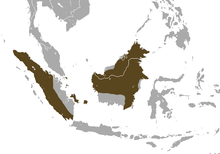Tana (pointed squirrel)
| Tana | ||||||||||||
|---|---|---|---|---|---|---|---|---|---|---|---|---|

Tana ( Tupaia tana ), drawing by Joseph Smit |
||||||||||||
| Systematics | ||||||||||||
|
||||||||||||
| Scientific name | ||||||||||||
| Tupaia tana | ||||||||||||
| Raffles , 1821 |
The tana ( Tupaia tana ) is a mammal in the genus of the real pointed squirrel that occurs in Southeast Asia .
features
The species is one of the larger members of the genus with an average head-trunk length of 22 cm and a weight of about 198 g. The bushy tail is shorter than the head-torso length. On the upper side there is dark brown fur with a conspicuous black eel line on the back and yellow shoulder stripes. The underside is covered by red-orange fur. Like other pointed squirrels, the Tana has a long, pointed snout, large eyes and bare ears. Depending on the distribution area, the tail is colored yellow, orange or red. The tana has long claws on the hands and feet and a complete set of teeth.
distribution
The Tana lives on Borneo and Sumatra as well as on various smaller islands in the region. It can be found in the flatlands and in lower areas of mountains, up to usually 1,200 m. Occasionally the animals reach a height of 1,500 m. The species can be found in forests and plantations. It prefers extensively managed forests with dense undergrowth.
Way of life
The individuals are diurnal and, in contrast to other members of the species, are mainly on the ground. Sometimes they climb trees for a better overview. Outside the mating season, males and females live separately. They establish territories of 300 to 600 m² in size, with a certain overlap being common. The tana marks its territory with secretions from the glands on the chin and anus.
Invertebrates such as earthworms, wolverines , insects and their larvae, spiders , cockroaches or crickets make up the main component of the diet. To do this, the pointed squirrel digs with its claws in the leafy layer or in the upper part of the earth. The main diet is completed with small mammals, lizards and the soft components of fruits.
During the mating season from August to November, the male forms a monogamous pair with one of the females with whom it shares areas of its territory . Before the offspring are born, the female builds a spherical nest out of twigs, bark and leaves that is hidden in bushes or on trees. A litter usually consists of twins who are nursed for 25 to 33 days. It is noticeable that the young animals are only visited every other day during this time, while care increases later. Older young animals accompany the mother on her hikes. A life expectancy of 10 to 14 years is known for the Tana.
status
Despite a fairly good adaptability, deforestation can have a negative impact on the population. The IUCN lists the Tana as Least Concern .
Individual evidence
- ↑ Don E. Wilson, DeeAnn M. Reeder (Ed.): Mammal Species of the World . A Taxonomic and Geographic Reference . 3. Edition. tape 1 . Johns Hopkins University Press, Baltimore 2005, ISBN 0-8018-8221-4 (English, Tupaia tana [accessed December 21, 2017]).
- ↑ a b c d Emmeline Miller: Large tree shrew in the Animal Diversity Web of the University of Michigan Museum of Zoology. 2007. Accessed December 21, 2017.
- ↑ a b Tupaia tana in the endangered Red List species the IUCN 2016 Posted by: Cassola, F., 2016. Accessed December 21, 2017th
